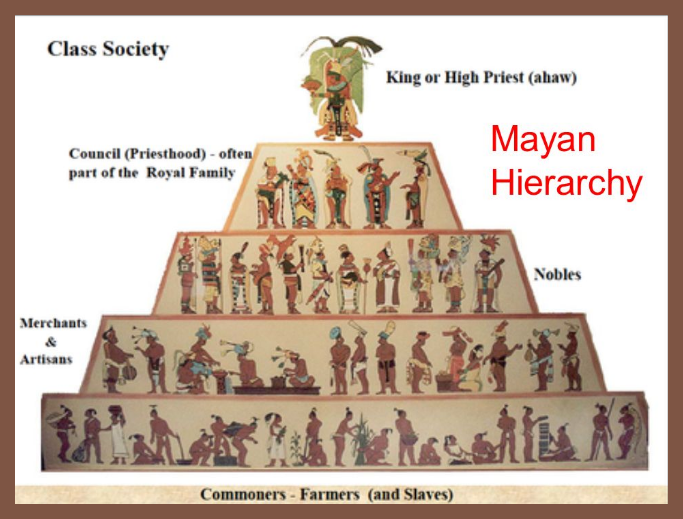MAYAN CIVILIZATIONS
Unit Overview
In this unit, you are going to learn that early Mayan Indian civilizations existed in the Western Hemisphere prior to the arrival of Europeans. These civilizations had developed unique governments, social structures, religions, technologies, and agricultural practices and products
Print and complete the Ancient Civilizations Graphic Organizer as you read and study the following information about the Maya Civilizations.
Maya
The Mayan civilization was formed as early as 1500 B.C. Migrants from Asia crossed an ancient land bridge during the Ice Age. Their descendants developed from a hunter-gatherer to a farming society. In Meso-America, the ancient Olmec civilization gave way to the Mayans. This complex civilization featured a rigid class structure, cities with beautiful temples and art, and highly developed scientific achievements. It also featured human blood sacrifice. The Mayan civilization went into decline and was eclipsed by the Toltecs.
Classic Maya culture developed in three regions in Mesoamerica. By far the most complete urban developments were in the lowlands in the "central region" of southern Guatemala. This region is a drainage basin about sixty miles long and twenty miles wide and covered by tropical rain forest. The principal city in this region was Tikal. The most Southern Mayan city was Copan in northern Honduras. In the Guatemalan highlands to the north, Mayan culture developed less fully. The highlands seem to have been the main suppliers of raw materials to the central urban centers.
Almost all the urban centers were built in tropical rain forests. This is probably the biggest reason why the Mayans never developed a fully urban culture. Tropical rain forests are difficult to live in, and can only support small groups of humans. While plant and animal growth seems almost out of control and the rains never stop, tropical rain forests make very poor farming land. A greater amount of area is required to support each person—and people tend to spread out rather than form cities.

Government
The Maya civilization consisted of a large number of city-states. Each city-state had its own independent government. A city-state was made up of a major city and the surrounding areas which sometimes included some smaller settlements and cities. Each city-state was ruled by a king. The Maya believed that their king was given the right to rule by the gods. They believed that the king worked as an intermediary between the people and the gods. The position of king was usually inherited by the oldest son. If there was not a son, then the oldest brother became king. There were also powerful councils of leaders who ran the government. They were chosen from the class of nobles.
Because religion was an important part of the Maya life, the priests were powerful figures in the government as well. In some ways the king was considered a priest, too. The kings of the Maya often came to the priests for advice on what to do in a crisis and to get predictions of the future. As a result, the priests had great influence on how the king ruled.
The Maya had strict laws. Crimes such as murder, arson, and acts against the gods were often punished with death. The punishment was much reduced, however, if it was determined that the crime was an accident. If you broke a law you appeared in court where the local leaders or nobles served as judge. In some cases the king would serve as judge. At the trial the judge would review evidence and listen to witnesses. If the person was found guilty, the punishment was carried out immediately. The Maya did not have prisons. Punishment for crimes included death, slavery, and fines. Sometimes they would shave the person's head as this was considered a sign of shame. If the victim of the crime wanted to pardon or forgive the accused, then the punishment may be reduced. The Maya nobles were also subject to the law. If a noble was found guilty of a crime, they were often punished even more severely than a commoner.
Social Structures
Maya people had a class structured society. At the top were the nobles and priests. They had a middle class of craftsmen, traders, and warriors. At the bottom, as usually in ancient time, were the farmers and slaves. The Maya did not use their own people as slaves. Slaves were captured from other tribes.

Although much of the Maya life was spent doing hard work, they did enjoy entertainment as well. A lot of their entertainment was centered around religious ceremonies. They played music, danced, and played outdoor games such as the Maya ball game. The Maya ball game was called Pok-A-Tok. These games could go on for days. It was played on an odd shaped field. The object of the game was to move a hard rubber ball without the use of hands or feet. It was not hard to keep score, since it took so long to get the ball through the stone hoop. The losing team was usually sacrificed.
Religion
The complex Mayan society centered on their religious beliefs and calendar system. The Mayan religion centered around the worship of many nature gods. Their amazing architecture remains as great ruins at centers they used for religious ceremonies, including Palenque, Uxmal, Copán, Tikal and Chichén Itzá. Religious ceremonies included dancing, games plays, prayer, and sacrifice. The gods required nourishment from human beings in order to work. While sacrifice often involved food, most sacrifice involved some form of human sacrifice. Priests and noblemen would willingly pierce body parts, usually their tongue, ears or lips and "give" blood to the gods.
The more important a person was in their society, the more blood they were expected to give to the gods.
Technology
They developed astronomy, calendar systems and writing. They built observatories to watch stars. They were highly skilled as potters and weavers.
The Mayans are known for their pyramids which vary in shape depending on where they are built. The Maya are perhaps most known for their many majestic pyramids. They built two kinds of pyramids. Both types of pyramids were similar in many ways. They each had the familiar pyramid shape. They each had steep steps up the side that would allow someone to climb to the top. They each were built for religious purposes and for the gods. However, they had their differences as well. The first type of pyramid had a temple on the top and was meant to be climbed by the priests to make sacrifices to the gods. The stairs going up the sides of these pyramids were steep, but not too steep for the priests to climb. The most important religious ceremonies were held at the top of these pyramids. The second type of pyramid was a sacred pyramid built to a god. These pyramids were not to be climbed or touched by humans. There were still steps going up the sides of these pyramids, but they were often too steep to climb without a lot of effort. These pyramids were sometimes built with secret doors, tunnels, and traps.
Causeways, the roads Mayans walked on, were often built up to four feet above ground level and measured up to fifteen feet wide. These, too, were man-made by slaves and government workers. Influences of the architecture and style of the Mayas can be seen in the resort area of Cancun, Mexico today.
Agriculture
The Maya were skillful farmers. They used their knowledge of calendars and seasons to grow crops. In the beginning, they grew more food than they needed. City-states did trade some surplus food for other items. But most of the surplus food was stored by each city-state to feed anyone who needed it in that city-state. The Maya did not try to use one system of agriculture. The farmers in each city-state fit their system to the land:
- In the mountainous highlands, they used step farming, so that each step would be flat and able to be irrigated to better grow and harvest crops.
- In the swampy lowlands, the Maya built raised earth platforms, surrounded by canals, on which they could grow crops.
- In the dense forest, they used a slash and burn technique to create a flat surface to plant crops. They dug canals throughout the fields to irrigate the crops.
The Maya ate very well. They hunted wild turkey, deer, ducks, and even monkey. They caught fish. They ate bird eggs. They grew sweet potatoes, corn, beans, chilies, and squash. Corn was called maize. Out of all their foods, maize was the most important. They made corn flour and used it to make tortillas and other kinds of breads.
 |
| Unit 10 Mayan Civilization Activity |
Now answer the questions!